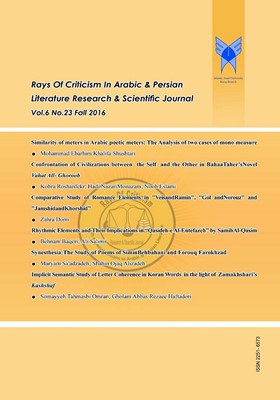Confrontation of Civilizations between the Self and the Other in BahaaTaher’sNovel Vahat All- Ghoroob
Subject Areas : Literary criticismKobra Roshanfekr 1 , Hadi NazariMonazam 2 , Nooh Eslami 3 *
1 - Assistant Prof. ,Department of Arabic Language and Literature ,Tarbiat Modarres University, Tehran, Iran
2 - Assistant Professor, Department of Arabic Language and LiteratureDepartment, TarbiatModarres University, Tehran, Iran
3 - M.A. Student, Department of Arabic Language and LiteratureDepartment, Tarbiat Modarres University, Tehran, Iran
Keywords: Image recognition, صورولوجیا, الأنا والآخر, بهاء طاهر, روایة واحة الغروب, the self and the other, BahaTaher, vahat Al-Ghoroob,
Abstract :
Civilization means pervasive progress in areas such as justice, relationships, behaviors and cultures of two groups. Each civilization presents to other civilizations intentionally or unintentionally what it owns. What leads to the dialogue between civilizations is their relationships and conflictions through wars and conquests as it happened in the history and is depicted sometimes in literary texts. Image recognition is a science which presents the image of a country or a nation in a way that helps the researcher to discover the presented images. Of the structures of this science is the image of the other which is contrasted with the image of ego. BahaTaher, the contemporary Egyptian novelist dedicated part of his novel Vahat Al-Ghoroobto present trilateral dialectic between the ego (Egyptian civilization) and the other (Greek civilization represented by Alexander the Great and Persian civilization represented by king Darius) andhe speaks about Egyptians (collective ego) and Persians and their king Darius and his army (negative other) from the other perspective. This research aims to study the presented images of Alexander the Great and Persians in the novel Vahat Al-Ghoroobrelyingon descriptive-analytical and historical approach and by investigating the dialogues taking place between characters of the novel. The results indicate that the positive western other is exemplifiedin Alexander the Great and the author pictures him as someone who possesses human virtues and has been popular among Egyptians. Someone who integrates the world in his egotism after his wars with Persians.
اصغری، جواد. (1390ش). «ویژگیهای فنی وموضوعی داستان درآثار بهاء طاهر». مجلة زبان وادبیات عربی، العدد4، صص 25-46.
اقبالی، علی. (1386ش). ذوالقرنین: اسکندر-کورش. تهران: نازلی.
باجو، دانیل هنری. (1997 م). الأدب العام والمقارن. ترجمه: غسان السید. دمشق: منشورات اتحاد کتاب العرب.
بدیع، امیر مهدی. (1343ش). یونانیان و بربرها. ترجمه: أحمد آرام. تهران: شرکت سهامی للنشر.
بروینی، خلیل وهادی نظری منظم وکاوه خضری .(1391ش). «صورة مایاکوفسکی فی شعر عبدالوهاب البیاتی وشیرکوبیکس؛ دراسة صورولوجیة فی الأدب المقارن». فصلیة إضاءات نقدیة فی الأدبین العربی والفارسی. العدد 8. صص 55-75
حمود، ماجدة. (2010م). صورة الآخر فی التراث العربی. الطبعة الأولی. الجزائر: منشورات الاختلاف.
خانکی، عزیز. (1360ش). «حیاة اسکندر الأکبر و غزو مصر». مجلة الثقافة. العدد 157. صص 9-225.
الخباز، محمد. (2009م). صورة الآخر فی شعر المتنبی. الطبعة الأولی. بیروت: مؤسسة العربیة للدراسات والنشر.
السلیمانی، أحمد یاسین. (2009 م). التجلیات الفنیة لعلاقة الأنا بالآخر فی الشعر العربی المعاصر». الطبعة الأولی. دمشق: دار الزمان.
شدود، ماجد. ( 2002م). حوار الحضارات. دمشق: هیئة المعلومات للطباعة والنشر.
طاهر، بهاء. (2008 م). واحة الغروب. الطبعة الأولی. القاهرة: دار الشروق.
فتحی، أبوالعینین. (1999 م). صورة الذات وصورة الآخر فی الخطاب الروائی العربی. بیروت: دراسات الوحدة العربیة.
فیروزمندی شیره جینی، بهمن ودیگران. (1392ش). «از اسکندر گجستک تا اسکندر ذوالقرنین». مجلة پژوهشهای ایرانشناسی. السنة الثالثة. الرقم1.صص 65-84.
الفیومی، سعید محمد. (2011م). «جدلیة الأنا والآخر فی روایة المتشائل أنموذجا». مجلة الجامعة الإسلامیة (سلسلة الدراسات الإنسانیة). العدد الأول. صص865-882.
کاظمزاده، فاطمه وعبده عبود وسعید بزرگ بیگدلی. ( 2013م). «صورة الآخر فی روایة قبل الرحیل لیوسف جاد الحق». مجلة العلوم الإنسانیة الدولیة. العدد 20. صص 73-88.
کاظم، نادر. (2002م). تمثیلات الآخر، صورة السود فی المتخیل العربی الوسیط. الطبعة الأولی. بیروت: المؤسسة العربیة للدراسات والنشر.
لمپ، هارولد وهرودوت. ( 1386ش). قدم به قدم با إسکندر در ایران. ترجمه ذبیح الله منصوری. الطبعة الثامنة. تهران: گلریز.
ماجدولین، شرف الدین. ( 2012 م). الفتنة والآخر. الطبعة الأولی. الجزائر: منشورات الاختلاف.
محمودآبادی، سید أصغر. (1382ش). «نقدی بر اندیشه تاریخنگاری عهد اسکندر مقدونی در ایران». مجلة ایرانشناسی. الرقم 5. صص 296-319.
نامور مطلق، بهمن. (1388ش). «درآمدی بر تصویرشناسی». فصلیة مطالعات ادبیات تطبیقی. العدد12. صص 119-138.
نانکت، لاتیشیا. (1390ش). «تصویرشناسی به منزله خوانش متون نثر معاصر فرانسه وفارسی». ترجمه مژده دقیقی. مجلة أدبیات تطبیقی 1و2. پیاپی 3. صص 100-115.
_||_

